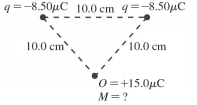Two point charges q = -8.50 µC are fixed 10.0 cm apart along a horizontal bar, as shown in the figure. Their electrical forces will be used to balance the weight of a very small sphere carrying a charge 10.0 cm from each of them in a place where g = 9.80 m/s2. What is the greatest mass M this sphere can have without falling? (k = 1/4??0 = 8.99 × 109 N ? m2/C2) 
Definitions:
Physical Units Method
An inventory costing method that allocates expenses based on the physical units produced or available, commonly used for homogeneous products.
Actual Physical Units
Actual physical units refer to the tangible quantity of items produced, held in inventory, or sold, as measured by physical count.
Joint Costs
Costs that are incurred in the process of producing two or more products simultaneously and cannot be easily separated for each product.
Market Value at Split-Off Method
A method used in accounting to allocate joint costs among products on the basis of their respective market values at the point where they are separable or split-off.
Q4: A portion of a circuit is shown
Q16: The graph shown in the figure shows
Q30: For the circuit shown in the figure,
Q48: A piece of glass has a thin
Q72: An asteroid of mass 58,000 kg
Q108: Consider an experiment using a diffraction
Q124: You are given a copper bar of
Q136: Identical ideal batteries are connected in different
Q137: A farsighted girl has a near point
Q143: What is the magnitude of the potential